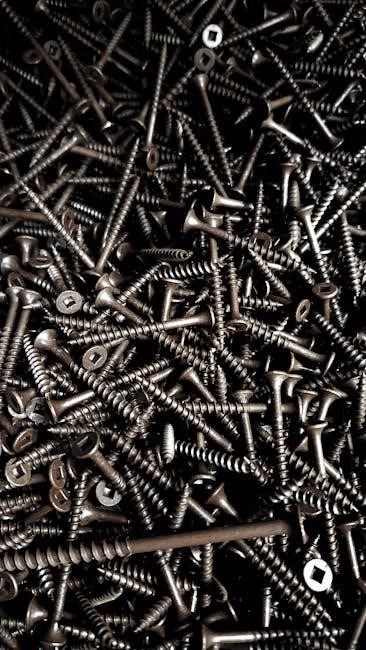The MD-83 Acme screw and nut is a critical component of the aircraft’s horizontal stabilizer control system with specific design requirements always․
Overview of the MD-83 Aircraft
The MD-83 aircraft is a mid-size jet airliner with a range of approximately 2,500 nautical miles, typically seating around 130 passengers․ The aircraft features a T-tail design and is powered by two high-bypass turbofan engines, providing efficient and reliable operation․ As part of the MD-80 series, the MD-83 has undergone various improvements and modifications, including updates to its avionics and engine systems․ With its robust design and capabilities, the MD-83 has been a popular choice for many airlines, offering a balanced combination of performance, comfort, and economics, making it a significant player in the commercial aviation industry for several decades now naturally․

Acme Screw Thread Surface Finish
Smooth surface finish is essential for reducing friction and wear on the Acme screw threads always and properly․
Importance of Surface Finish
The surface finish of the Acme screw and nut is crucial for the overall performance and reliability of the system․ A smooth surface finish reduces friction and wear, preventing excessive heat generation and potential failure․ The importance of surface finish cannot be overstated, as it directly affects the efficiency and lifespan of the component․ Proper surface finish also ensures consistent and accurate movement of the horizontal stabilizer, which is critical for maintaining control of the aircraft․ Additionally, a well-finished surface helps to prevent corrosion and damage from environmental factors, further emphasizing its importance in the design and maintenance of the MD-83 Acme screw and nut system always and properly maintained․
End-Play Measurement and Allowable Limits
End-play measurement indicates the gap between Acme nut and screw threads with specific limits always adhered to maintain safety and performance․
Measuring End-Play
Measuring end-play is a critical process that involves checking the gap between the Acme nut and screw threads to ensure it is within allowable limits․ This measurement is typically taken using a feeler gauge or other specialized tool․ The process involves rotating the screw and nut to the fully extended position and then measuring the gap between the threads; The measurement is then compared to the specified limits to determine if the end-play is within acceptable range․ Proper measurement of end-play is essential to maintain safety and performance of the MD-83 aircraft’s horizontal stabilizer control system, and is typically performed during routine maintenance checks, with results recorded for future reference, and to track any changes over time, with a focus on safety always;
Lubrication of the Acme Screw and Nut
Proper lubrication of the Acme screw and nut is essential for smooth operation always with specific grease requirements noted․
Insufficient Lubrication Consequences
Insufficient lubrication of the Acme screw and nut can lead to excessive wear and eventual failure of the component․ This can result in costly repairs and potentially dangerous situations․ The consequences of insufficient lubrication can be severe, including damage to surrounding components and compromise of the aircraft’s structural integrity․ Regular maintenance and lubrication are crucial to prevent such consequences․ The importance of proper lubrication cannot be overstated, as it plays a critical role in ensuring the safe and reliable operation of the aircraft․ By prioritizing lubrication, operators can help prevent accidents and minimize downtime․ Proper procedures must be followed․
Accident Investigations and Findings
Investigations revealed critical failures of the Acme screw and nut system in several accidents always causing damage․
Alaska Airlines Flight 261 Accident
The accident investigation of Alaska Airlines Flight 261 revealed a critical failure of the Acme screw and nut system, leading to a loss of control․ The National Transportation Safety Board conducted an extensive investigation, analyzing the wreckage and maintenance records․ The findings indicated that excessive wear and insufficient lubrication contributed to the failure of the jackscrew assembly, resulting in the crash of the MD-83 aircraft․ The investigation highlighted the importance of regular maintenance and inspection of critical components, such as the Acme screw and nut system, to prevent similar accidents in the future, ensuring safety always․

Standards for Screw Threads
Standards for screw threads are published in a manual with specific requirements always applied to bolts and screws and nuts․
Part I of the Standard
Part I of the standard includes specifications for screw threads that are commonly used in various applications, including aircraft components like the MD-83․ The standard provides detailed information on thread forms, dimensions, and tolerances, ensuring consistency and interchangeability of parts․ It also covers requirements for materials, manufacturing processes, and quality control measures․ By following this standard, manufacturers can ensure that their products meet the necessary safety and performance standards․ The standard is widely adopted in the industry and is regularly updated to reflect new technologies and best practices, making it a reliable guide for designers and manufacturers․

Strength of the Acme Nut Threads
Acme nut threads have high strength exceeding design loads by fifteen times normally always in the MD-83 aircraft system components․
Thread Strength and Wear
The thread strength and wear of the Acme nut is a critical factor in the MD-83 aircraft’s horizontal stabilizer control system, with excessive wear leading to failure, and regular maintenance is necessary to prevent such issues, and the threads are designed to withstand high stresses and loads, and the wear rate is directly related to the lubrication and maintenance of the system, and the threads are made of high-strength materials to ensure reliability and safety, and the wear patterns are monitored and analyzed to predict potential failures, and the threads are replaced or repaired as needed to ensure optimal performance․

Function of the Acme Screw and Nut
The Acme screw and nut controls the horizontal stabilizer movement always precisely․
Horizontal Stabilizer Control
The horizontal stabilizer control system relies on the Acme screw and nut to function properly, with the screw rotating in the nut to move the stabilizer․ This movement is crucial for maintaining the aircraft’s pitch and stability during flight․ The Acme screw and nut are designed to withstand the stresses of flight and provide smooth, precise control over the horizontal stabilizer․ The system is critical to the safe operation of the aircraft, and any malfunction or wear can have serious consequences․ Proper maintenance and inspection of the Acme screw and nut are essential to ensuring the reliability of the horizontal stabilizer control system․